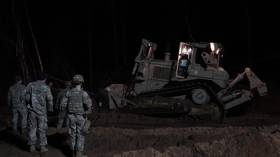Effects of toxic Samsung spill in Texas laid bare

A major spill of industrial waste in Texas, traced back to Samsung Austin Semiconductor – the only manufacturing facility maintained by the South Korean multinational on US soil – has destroyed local aquatic life, according to a watchdog report.
The spill was brought to light by Texas environmental watchdog the Watershed Protection Department (WPD), last week. The organization notified Austin authorities of the incident, describing the spill as a “large discharge of sulfuric acid waste.”
“While it is unknown how much waste entered the tributary, Watershed Protection Department (WPD) staff found virtually no surviving aquatic life within the entire tributary from the Samsung property to the main branch of Harris Branch Creek, near Harris Branch Parkway,” the watchdog stated in a memorandum sent to Austin mayor and council.
The demise of aquatic life was almost certain as pH levels in the creek rose to between 3 and 4, effectively leaving the creatures in a substance as acidic as tomato juice. The spill, however, has not apparently spread further downstream, with “no measurable impacts to water chemistry or aquatic life” noted in Harris Branch Creek itself, according to WPD.
The spill involved up to 763,000 gallons (nearly 2.9 million liters) of acidic industrial waste that leaked from the factory, before getting into its stormwater pond and flowing into the creek afterwards.
While it was not immediately clear exactly how much of the spilled waste entered the waterway, Samsung insisted a vast part of it remained contained on the factory’s premises. The leak had been active for up to 106 days, before being found mid-January and fixed. The factory then recruited “a leading environmental engineering company as a partner” to help mitigate the impact of the spill, Samsung Austin’s spokesperson Michele Glaze said in a statement.
“A majority of the wastewater was contained on-site; however, a portion was inadvertently released into an unnamed small tributary that is upstream of Harris Branch Creek,” Glaze said, adding that the pH level in the affected creek “has already returned to normal conditions.”














